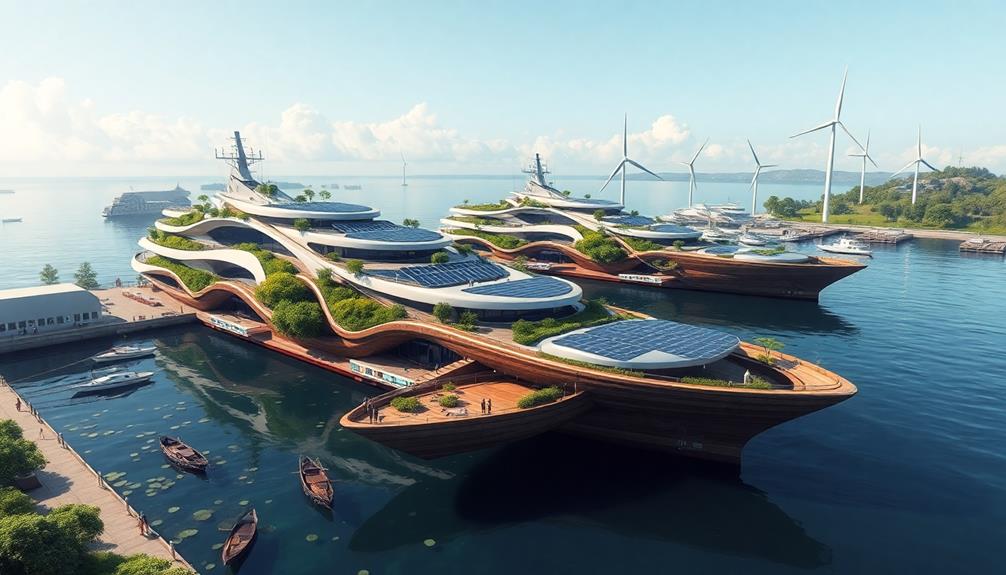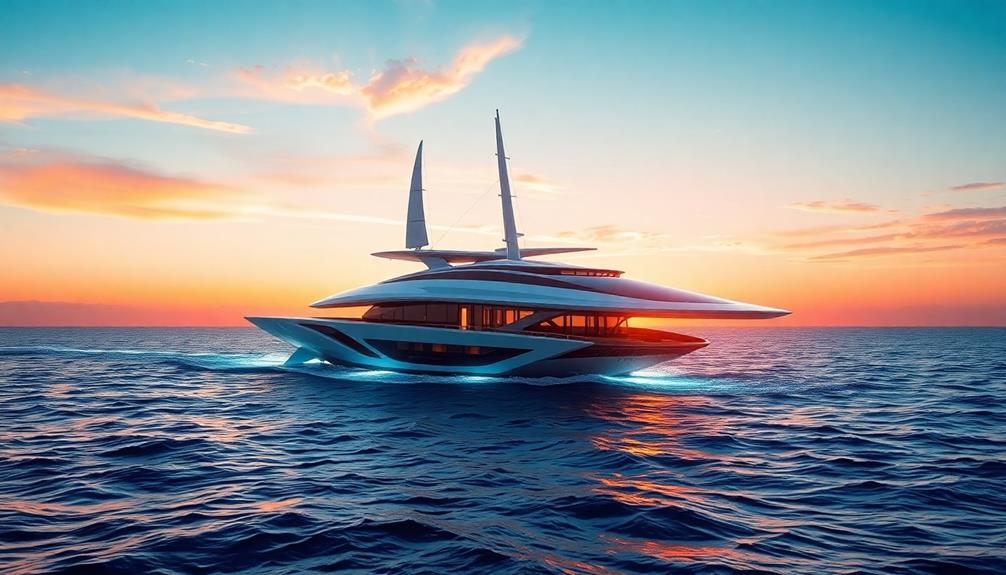Revealing the secrets of ship design lets you create your dream vessel with the perfect blend of performance and sustainability. Start by optimizing the hull shape to minimize drag and guarantee stability, which keeps your ship balanced in rough seas. Use advanced materials like steel and aluminum to enhance strength and durability. Embrace technological innovations, like IoT for real-time monitoring and energy-efficient propulsion systems. Don't forget the importance of safety features and adhering to environmental standards. The world of ship design is vast and full of exciting possibilities, and there's even more waiting for you to explore further.
Key Takeaways
- Optimize hull shape to reduce drag, enhancing speed and overall performance of your dream vessel.
- Select sustainable materials and energy-efficient systems to promote environmental responsibility in your ship design.
- Incorporate advanced technology like CAD software and IoT devices for precision and real-time monitoring.
- Prioritize stability and safety through thorough analysis, simulations, and adherence to regulatory standards.
- Explore innovative propulsion systems and alternative fuels to improve maneuverability and fuel efficiency.
Fundamentals of Ship Design

When you explore the fundamentals of ship design, it's vital to grasp the key design principles that guarantee a vessel's effectiveness and safety.
Start by optimizing the hull shape to minimize drag and enhance performance. Stability is important; you want your ship to remain upright and balanced in various sea conditions.
Next, focus on structural integrity—design a robust hull that can withstand the forces encountered at sea.
Don't forget about propulsion systems; they determine your vessel's speed and maneuverability while considering power output and fuel efficiency.
Sustainability in Shipbuilding

As you explore ship design, it’s clear that sustainability plays a pivotal role in modern shipbuilding. You’ll want to focus on using eco-friendly materials and energy-efficient systems. By implementing effective waste management and adhering to environmental regulations, you can considerably reduce your vessel’s carbon footprint. In addition to utilizing sustainable materials and energy-efficient systems, it’s also important to consider the end-of-life disposal of the vessel. This could involve designing for easier recycling or repurposing of materials. By taking a holistic approach to sustainability in ship design, you can appeal to a sustainable fashion target audience that values environmentally friendly options when it comes to transportation.
Here's a quick overview of key sustainable practices in shipbuilding:
| Practice | Description | Benefits |
|---|---|---|
| Sustainable Materials | Use of recycled or renewable resources | Reduced environmental impact |
| Energy-efficient Systems | Optimize power consumption | Lower operational costs |
| Emission-reducing Tech | Incorporate advanced propulsion methods | Minimized air pollution |
| Waste Management | Effective onboard recycling systems | Compliance with regulations |
| Regulatory Compliance | Adhere to environmental standards | Enhanced marketability |
Technological Innovations in Design

Technological innovations in ship design have revolutionized the industry, driving efficiency and performance to new heights.
You'll find that cutting-edge advancements are transforming how vessels are conceived and built. Here are some key innovations to evaluate:
- Conceptual Design: Utilize advanced CAD software for precise virtual modeling.
- Automation: Enhance navigation and control systems for improved operational efficiency.
- Green Technologies: Embrace alternative fuels and energy-efficient systems to minimize environmental impact.
- 3D Printing: Speed up prototyping and reduce costs through rapid manufacturing of components.
- Smart Systems: Implement IoT devices for real-time monitoring and maintenance, ensuring ideal performance.
Ensuring Ship Stability and Safety

Guaranteeing ship stability and safety is essential for the successful operation of any vessel. You need to prioritize stability analysis to keep your ship balanced and upright in various sea conditions. This involves advanced modeling and simulations to predict how your vessel will respond to waves and winds.
Installing safety measures like watertight compartments, fire suppression systems, and life-saving equipment is vital for the well-being of your crew and passengers. Compliance with regulatory standards, such as those set by the International Maritime Organization (IMO) and SOLAS Convention, can't be overlooked.
Regular inspections and surveys are necessary to maintain these safety standards and guarantee your ship remains fit for duty. Your commitment to stability and safety will lead to smoother sailing and peace of mind.
Key Materials for Construction

Choosing the right materials for ship construction greatly impacts performance, durability, and safety.
You'll want to select materials that balance strength with weight, ensuring your vessel can withstand the harsh marine environment.
Consider these key materials:
- Steel: Provides exceptional strength and durability for the hull.
- Aluminum: Lightweight and resistant to corrosion, ideal for smaller vessels.
- Composite Materials: Enhance performance and fuel efficiency while reducing weight.
- Wood: Offers aesthetic appeal and traditional charm, often used in smaller boats.
- Protective Coatings: Essential for longevity, these coatings shield against rust and wear.
Impact on Maneuverability

When considering a ship's design, the interplay between hull shape, weight distribution, and propulsion systems greatly affects its maneuverability. A well-designed hull allows for better flow dynamics, reducing drag and enhancing responsiveness. Proper weight distribution guarantees the vessel remains stable during turns, while effective propulsion systems provide the necessary thrust to change direction swiftly.
Here's a quick reference to key factors influencing maneuverability:
| Factor | Impact on Maneuverability |
|---|---|
| Hull Shape | Affects drag and stability |
| Weight Distribution | Guarantees balance during movement |
| Propulsion Systems | Determines speed and responsiveness |
| Rudder Design | Influences steering precision |
| Ballast Systems | Stabilizes during maneuvers |
These elements work together to create a vessel that responds effectively to your commands on the water.
Future Trends in Ship Design

The maritime industry is on the brink of transformation, driven by innovative trends that promise to redefine ship design.
You'll want to keep an eye on these exciting developments:
- Sustainability: Focus on eco-friendly materials and energy-efficient systems to reduce environmental impact.
- Autonomous Vessels: The rise of smart technology enables ships to navigate independently, enhancing safety and efficiency.
- Alternative Fuels: Adoption of hydrogen, LNG, and other renewable energy sources is becoming mainstream.
- 3D Printing: Rapid prototyping is streamlining production times and reducing costs.
- Advanced Materials: Innovations in composite materials improve strength and reduce weight, paving the way for more efficient designs.
These trends not only enhance ship performance but also align with global sustainability efforts, shaping a brighter future for maritime exploration.
Frequently Asked Questions
What Are the Essential Steps in the Ship Design Process?
In the ship design process, you'll assess requirements, create initial concepts, analyze stability and hydrodynamics, select materials, optimize propulsion systems, and guarantee compliance with regulations, ultimately balancing performance, safety, and environmental impact throughout.
How Do Cultural Influences Affect Ship Design Choices?
Cultural influences shape your ship design choices by reflecting local traditions, aesthetics, and environmental practices. You consider regional materials, design motifs, and sustainability preferences, ensuring your vessel resonates with its intended community and purpose.
What Role Does User Experience Play in Ship Design?
User experience shapes ship design through comfort and functionality; it balances aesthetics with practicality. You'll enjoy intuitive layouts, seamless navigation, and personalized spaces, ensuring your journey is as pleasant as it is efficient.
How Can I Finance My Ship Design Project?
To finance your ship design project, explore options like crowdfunding, seeking investors, applying for grants, or securing loans. Research financial institutions that support maritime projects, and prepare a solid business plan to attract funding.
What Are the Common Myths About Ship Design?
You might believe ship design's only about aesthetics or size, but it's really about stability, efficiency, and sustainability. Myths can mislead you; understanding the fundamentals guarantees your design's success and safety on the water.
Conclusion
So, there you have it—your treasure map to crafting the perfect vessel. You might've thought designing a ship was all about fancy gadgets and sleek lines, but it turns out it's really about balancing sustainability, safety, and good ol' seaworthiness. Who knew? Now you're ready to sail into the sunset with a ship that not only looks good but also does good. Just remember, when the waves get rough, it's not the design that matters, but how you handle it!









